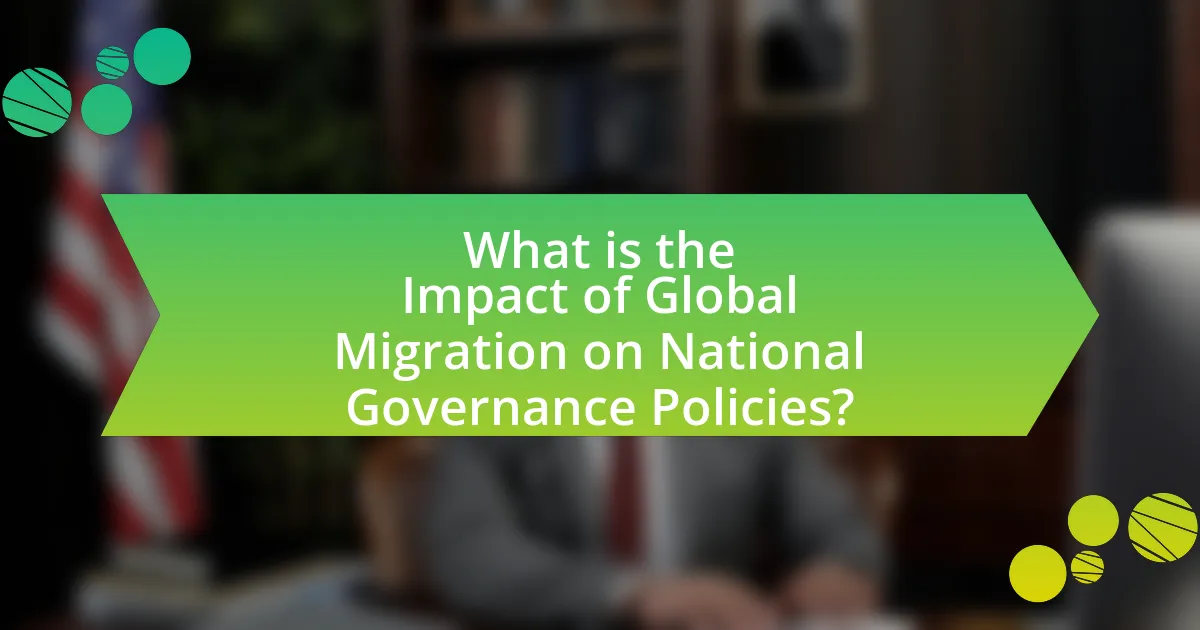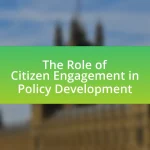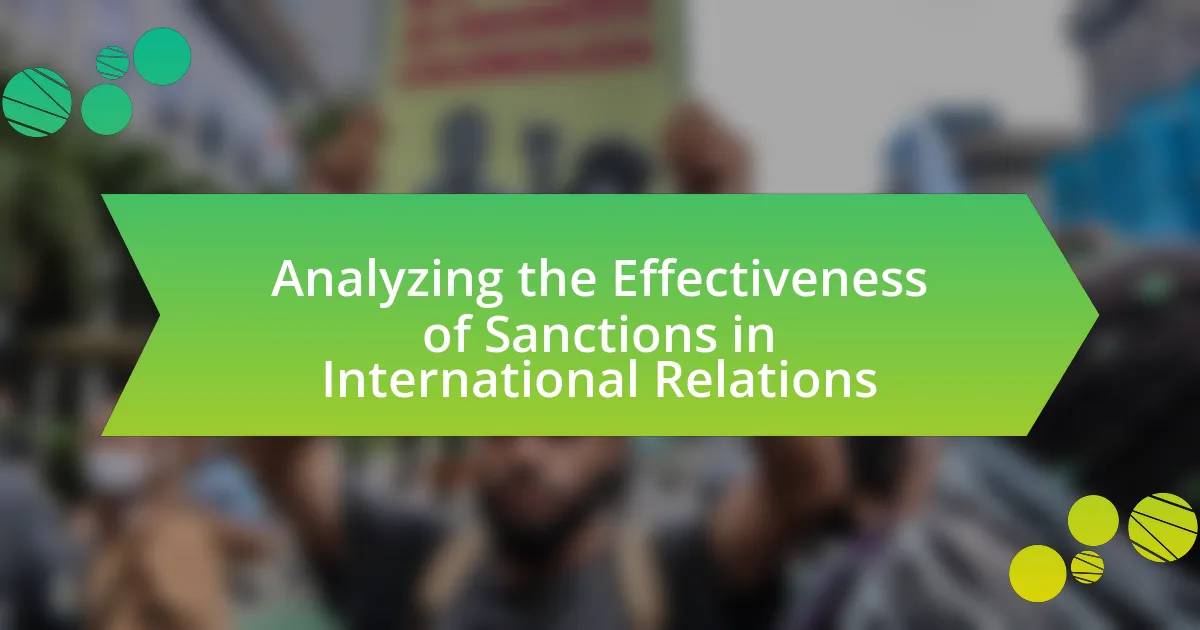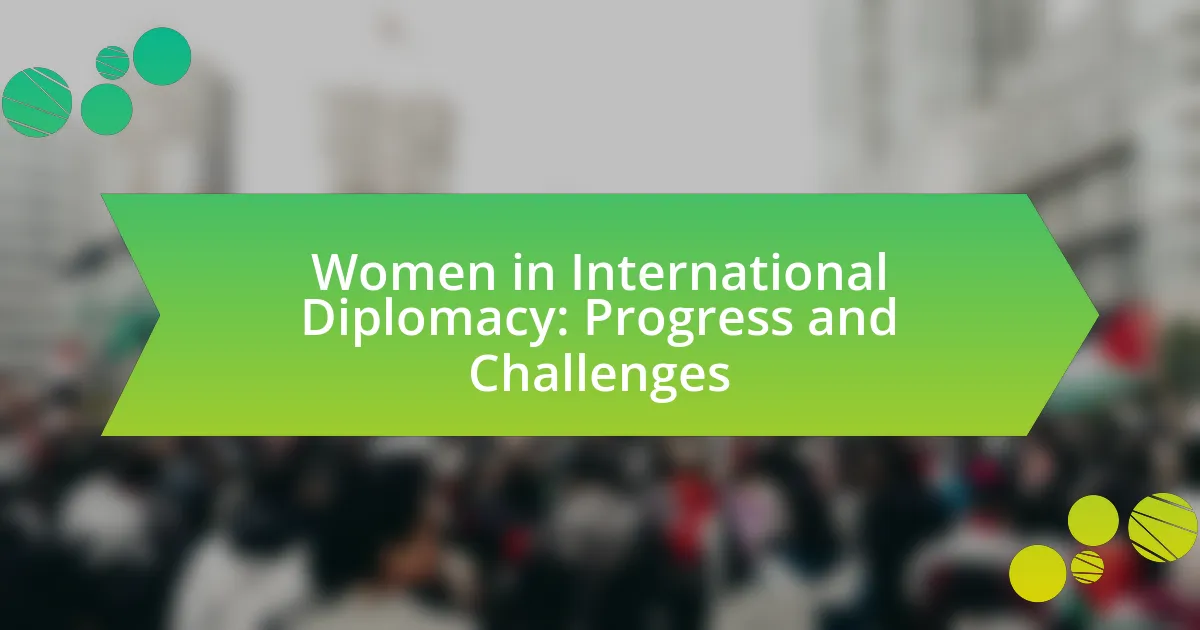The article examines the impact of global migration on national governance policies, highlighting how migration necessitates adjustments in immigration laws, social services, and economic strategies. It discusses the influence of demographic shifts, economic pressures, and social integration challenges on policy-making, with examples from countries like Canada and Germany. The article also addresses the importance of assessing migration’s effects on governance, the risks of ignoring migration in policy frameworks, and strategies for effective management, including integration programs and international cooperation. Additionally, it explores the role of public opinion and international agreements in shaping migration policies, emphasizing the need for comprehensive frameworks to balance the benefits and challenges of migration.

What is the Impact of Global Migration on National Governance Policies?
Global migration significantly influences national governance policies by necessitating adjustments in immigration laws, social services, and economic strategies. Countries experiencing high levels of migration often reform their policies to address challenges such as integration, labor market demands, and public service provision. For instance, the United Nations reports that in 2020, approximately 281 million people were international migrants, prompting nations to adapt their governance frameworks to manage diverse populations effectively. This adaptation includes implementing policies that promote social cohesion and economic contributions from migrants, as seen in countries like Canada, which has established points-based immigration systems to attract skilled workers.
How does global migration influence national policy-making?
Global migration significantly influences national policy-making by prompting governments to adapt their immigration laws, labor market regulations, and social integration policies. As countries experience varying levels of migration, they often respond by reforming policies to address economic needs, demographic changes, and social cohesion. For instance, the United Nations reports that in 2020, there were approximately 281 million international migrants, which has led many nations to reassess their immigration frameworks to attract skilled labor and fill labor shortages. Additionally, countries like Canada and Germany have implemented points-based immigration systems to streamline the process for skilled migrants, reflecting a direct response to labor market demands influenced by global migration trends.
What are the key factors driving changes in governance due to migration?
Key factors driving changes in governance due to migration include demographic shifts, economic pressures, and social integration challenges. Demographic shifts occur as migration alters population structures, leading to increased diversity and necessitating policy adaptations to accommodate various cultural needs. Economic pressures arise from the need to provide services and employment opportunities for both migrants and local populations, prompting governments to reform labor and welfare policies. Social integration challenges compel governments to implement strategies that promote cohesion and address potential conflicts, influencing governance frameworks. These factors collectively reshape national governance policies to respond effectively to the complexities introduced by migration.
How do different countries respond to migration in their governance policies?
Different countries respond to migration in their governance policies through a variety of approaches, including restrictive, selective, and inclusive policies. For instance, the United States has historically implemented strict immigration controls, exemplified by the Immigration and Nationality Act, which emphasizes border security and deportation. In contrast, Canada adopts a more selective approach, utilizing a points-based system that prioritizes skilled migrants, as evidenced by its Express Entry program, which aims to attract individuals who can contribute to the economy. Additionally, countries like Germany have implemented inclusive policies, particularly during the 2015 refugee crisis, where they welcomed a significant number of asylum seekers, reflecting a humanitarian response to migration. These varying responses are shaped by factors such as economic needs, political climate, and social attitudes towards migrants, demonstrating the complex interplay between migration and national governance policies.
Why is it important to assess the impact of migration on governance?
Assessing the impact of migration on governance is crucial because it informs policymakers about how migration influences political stability, social cohesion, and economic development. Understanding these dynamics allows governments to create effective policies that address the needs of both migrants and host communities. For instance, research by the International Organization for Migration indicates that well-managed migration can enhance economic growth and labor market flexibility, while poorly managed migration can lead to social tensions and strain public services. Therefore, evaluating migration’s effects on governance is essential for fostering inclusive and sustainable national policies.
What are the potential risks of ignoring migration in policy frameworks?
Ignoring migration in policy frameworks can lead to significant socio-economic and political risks. These risks include increased social tensions, as unaddressed migration issues can fuel xenophobia and discrimination against migrants, destabilizing communities. Additionally, neglecting migration can result in labor shortages in key sectors, as many economies rely on migrant workers to fill gaps in the labor market; for instance, the International Organization for Migration reported that migrants constitute a substantial portion of the workforce in industries such as agriculture and healthcare. Furthermore, failing to incorporate migration into policy can hinder effective integration strategies, leading to marginalized communities that lack access to essential services and opportunities, which can exacerbate inequality and social unrest.
How can understanding migration trends improve governance?
Understanding migration trends can significantly improve governance by enabling policymakers to make informed decisions that address the needs of both migrants and host communities. By analyzing data on migration patterns, such as the demographics, reasons for migration, and economic impacts, governments can tailor their policies to enhance social integration, allocate resources effectively, and anticipate challenges related to public services and infrastructure. For instance, the International Organization for Migration reported that countries that utilize migration data can better manage labor markets and address skills shortages, leading to economic growth and stability. This evidence illustrates that informed governance based on migration trends can lead to more effective and responsive national policies.

What are the Challenges Faced by National Governments Due to Migration?
National governments face several challenges due to migration, including strain on public services, social integration issues, and security concerns. The influx of migrants can overwhelm healthcare, education, and housing systems, leading to resource allocation conflicts. For instance, a report by the OECD in 2020 indicated that countries with high levels of migration often experience increased pressure on their welfare systems, which can lead to public discontent and political instability. Additionally, social integration challenges arise as migrants may face cultural barriers, leading to tensions within communities. Security concerns also escalate, as governments must address potential risks associated with undocumented migration and the movement of individuals across borders. These challenges necessitate comprehensive governance policies to effectively manage migration and its impacts.
How do migration patterns affect public services and resources?
Migration patterns significantly affect public services and resources by increasing demand for healthcare, education, and housing in host communities. For instance, a surge in migration can lead to overcrowded schools and hospitals, straining existing infrastructure and resources. According to the United Nations, in 2020, approximately 281 million people were international migrants, which has implications for public service allocation and funding. Local governments often face challenges in adapting to these changes, as they must balance the needs of both migrants and existing residents, leading to potential resource shortages and increased public expenditure.
What specific challenges arise in healthcare and education systems?
Healthcare and education systems face significant challenges due to global migration, including resource allocation, cultural integration, and policy adaptation. Resource allocation becomes strained as an influx of migrants increases demand for services, often outpacing available funding and infrastructure. Cultural integration issues arise when diverse populations require tailored educational and healthcare approaches, which can lead to disparities in access and quality of services. Additionally, existing policies may not adequately address the unique needs of migrant populations, necessitating reforms to ensure equitable access and support. For instance, a study by the World Health Organization highlights that countries experiencing high levels of migration often struggle to maintain healthcare quality due to increased patient loads and insufficient staffing.
How do local economies adapt to increased migration?
Local economies adapt to increased migration by diversifying their labor markets and enhancing service provision. As migrants enter a region, they often fill labor shortages in various sectors, such as agriculture, construction, and services, which can lead to economic growth. For instance, a study by the National Academies of Sciences, Engineering, and Medicine found that immigration contributes positively to the economy by increasing productivity and innovation. Additionally, local businesses may expand to cater to the needs of a growing population, leading to job creation and increased demand for goods and services. This adaptation process can also involve local governments implementing policies to support integration, such as language and job training programs, which further bolster economic resilience.
What role does public opinion play in shaping governance policies related to migration?
Public opinion significantly influences governance policies related to migration by shaping political agendas and decision-making processes. When a majority of the population expresses concerns or support for specific migration issues, policymakers often respond to these sentiments to align with voter preferences and maintain electoral support. For instance, surveys indicate that in countries like the United States and several European nations, public attitudes towards immigration have led to stricter border controls and changes in asylum policies, reflecting a direct response to perceived public demand for enhanced security and regulation. Additionally, political parties may adjust their platforms based on public opinion trends, as seen in the rise of populist movements that capitalize on anti-immigration sentiments, thereby further impacting legislative outcomes.
How can governments address public concerns about migration?
Governments can address public concerns about migration by implementing transparent communication strategies and engaging in community outreach. By providing clear information about migration policies, the benefits of migration, and addressing misconceptions, governments can foster a more informed public dialogue. For instance, studies show that countries with proactive communication strategies, such as Canada, have successfully mitigated public fears by highlighting the economic contributions of migrants, which accounted for a 1.6% increase in GDP in 2019 according to the OECD. Additionally, involving local communities in discussions about migration can help build trust and understanding, as evidenced by initiatives in Germany that have led to increased public support for migrants through local integration programs.
What strategies can be employed to foster positive perceptions of migrants?
To foster positive perceptions of migrants, community engagement initiatives can be employed, such as cultural exchange programs and local integration projects. These strategies encourage interaction between migrants and host communities, promoting understanding and reducing stereotypes. Research indicates that areas with active community engagement report higher levels of acceptance and lower levels of xenophobia. For example, a study by the Migration Policy Institute found that cities implementing inclusive policies and programs saw a significant increase in positive attitudes towards migrants, highlighting the effectiveness of direct interaction in changing perceptions.

What Strategies Can National Governments Implement to Manage Migration Effectively?
National governments can implement comprehensive immigration policies, including streamlined visa processes, to manage migration effectively. Streamlined visa processes facilitate legal entry, reducing the burden on border control and enhancing security. Additionally, governments can establish integration programs that promote social cohesion and economic participation of migrants, which has been shown to improve community relations and reduce tensions. For instance, countries like Canada have successfully utilized points-based immigration systems to attract skilled workers, resulting in positive economic contributions and demographic balance. Furthermore, international cooperation on migration management, such as sharing best practices and resources, can enhance national strategies, as evidenced by the Global Compact for Migration adopted by the United Nations in 2018, which encourages collaborative approaches to migration challenges.
How can policies be designed to balance migration benefits and challenges?
Policies can be designed to balance migration benefits and challenges by implementing comprehensive frameworks that address economic, social, and security aspects of migration. These frameworks should include targeted labor market assessments to identify sectors in need of workers, thereby maximizing economic contributions while minimizing unemployment risks for local populations.
Additionally, policies must incorporate integration programs that promote social cohesion, such as language training and cultural orientation, which can reduce tensions and enhance community acceptance of migrants. Evidence from the OECD indicates that well-integrated migrants contribute significantly to economic growth, with studies showing that they can increase GDP by up to 2% in host countries.
Furthermore, effective border management and security measures are essential to address public concerns about safety and illegal migration. Countries like Canada have successfully balanced these elements by creating pathways for skilled migrants while ensuring robust enforcement against irregular migration. This multifaceted approach allows for the harnessing of migration’s benefits while effectively managing its challenges.
What best practices exist for integrating migrants into society?
Best practices for integrating migrants into society include providing language education, facilitating access to employment, promoting social inclusion, and ensuring access to essential services. Language education is crucial as it enables migrants to communicate effectively and participate in the community, which is supported by studies showing that proficiency in the host country’s language significantly enhances employment opportunities and social interactions. Facilitating access to employment through job training programs and recognition of foreign qualifications helps migrants contribute economically, as evidenced by research indicating that economically active migrants can boost local economies. Promoting social inclusion through community engagement initiatives fosters relationships between migrants and local residents, reducing social tensions and enhancing cohesion. Lastly, ensuring access to essential services such as healthcare and education is vital for the well-being of migrants and their families, with studies highlighting that access to these services leads to better integration outcomes and overall societal benefits.
How can governments ensure the protection of migrant rights?
Governments can ensure the protection of migrant rights by implementing comprehensive legal frameworks that align with international human rights standards. These frameworks should include laws that prohibit discrimination, guarantee access to essential services, and provide pathways for legal residency. For instance, the International Organization for Migration emphasizes that countries adhering to the Global Compact for Safe, Orderly and Regular Migration commit to protecting the rights of all migrants, regardless of their status. Additionally, governments can establish independent monitoring bodies to oversee the treatment of migrants and ensure accountability for violations. This approach is supported by the United Nations High Commissioner for Refugees, which advocates for the establishment of mechanisms that allow migrants to report abuses without fear of retribution.
What are the implications of international agreements on national governance regarding migration?
International agreements on migration significantly influence national governance by establishing frameworks that guide policy formulation and implementation. These agreements, such as the Global Compact for Safe, Orderly and Regular Migration, compel nations to align their domestic laws with international standards, promoting cooperation and shared responsibility among countries. For instance, countries that ratify such agreements often adopt policies that enhance border security, improve migrant rights, and facilitate legal pathways for migration, thereby shaping their governance structures. Additionally, compliance with international agreements can lead to increased funding and support from international organizations, which further impacts national policy priorities and resource allocation.
How do global frameworks influence national policy decisions?
Global frameworks influence national policy decisions by establishing guidelines and standards that countries are encouraged to adopt. These frameworks, such as the Global Compact for Migration, provide a structured approach to addressing issues like migration, which can lead to harmonized policies across nations. For instance, countries that participate in international agreements often align their immigration laws with the principles outlined in these frameworks, promoting cooperation and shared responsibility. This alignment is evidenced by the adoption of similar border management practices and migrant protection measures among signatory countries, demonstrating the tangible impact of global frameworks on national governance policies.
What role do NGOs and international organizations play in shaping these policies?
NGOs and international organizations play a crucial role in shaping national governance policies related to global migration by advocating for human rights, providing expertise, and facilitating dialogue among stakeholders. These entities often conduct research and gather data that inform policy decisions, highlighting the social, economic, and humanitarian impacts of migration. For instance, the International Organization for Migration (IOM) provides member states with guidelines and best practices for managing migration effectively, which influences national policies. Additionally, NGOs like Amnesty International and Human Rights Watch raise awareness about the rights of migrants, pressuring governments to adopt more inclusive and protective policies. Their involvement ensures that diverse perspectives are considered in policy formulation, ultimately leading to more comprehensive and effective governance frameworks.
What practical steps can governments take to enhance their migration governance frameworks?
Governments can enhance their migration governance frameworks by implementing comprehensive policy reforms that address legal, economic, and social dimensions of migration. These reforms should include establishing clear legal pathways for migration, which can reduce irregular migration and improve the safety of migrants. For instance, countries like Canada have successfully utilized points-based immigration systems to attract skilled workers, demonstrating that structured approaches can lead to positive economic outcomes.
Additionally, governments should invest in data collection and analysis to better understand migration trends and impacts. Accurate data enables informed decision-making and policy adjustments, as seen in the European Union’s use of the Eurostat database to track migration statistics and inform policy.
Furthermore, fostering international cooperation is crucial. Collaborative efforts, such as the Global Compact for Safe, Orderly and Regular Migration, provide frameworks for countries to share best practices and resources, enhancing overall governance. Countries that engage in bilateral agreements to manage migration flows, like the agreements between the United States and Mexico, illustrate the effectiveness of cooperative governance.
Lastly, governments should prioritize the integration of migrants into society through access to education, healthcare, and employment opportunities. Successful integration policies, such as those implemented in Germany, have shown that supporting migrants can lead to social cohesion and economic benefits for host countries.






